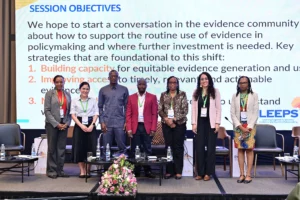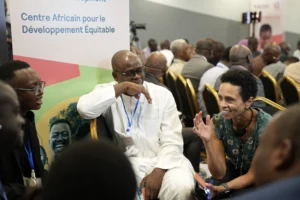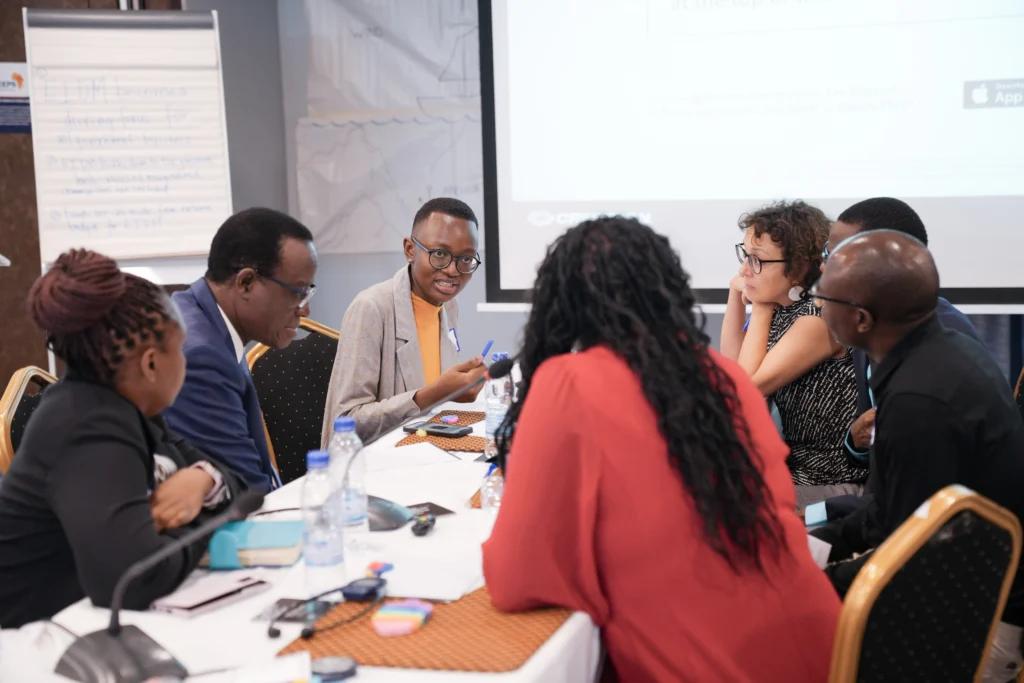Authors: Amy Nye, Senior Program Officer, R4D, Natasha Ledlie, Program Director, R4D
This blog was developed with input from Violet Murunga (African Institute for Development Policy); Amadou Gueye (Initiative Prospective Agricole et Rural); Pauline Ngimwa (The Partnership for African Social and Governance Research), Vincent Were (African Population and Health Research Center); and Catherine Botros-Odingo (Teaching at the Right Level Africa).
Introduction
Evidence-informed policymaking (EIP) is the use of the best available evidence to inform or influence the design, implementation, monitoring, and assessment of policies and programs. Local, timely, and quality evidence provides needed contextual information to ensure that policies are responsive, efficient, and equitable. While there is growing momentum toward EIP across Africa, a key question persists: what does it take to make the use of evidence consistent and routine in policymaking? The answer goes beyond generating high-quality research. It involves building long-term relationships, strengthening institutional systems, and navigating the political and operational realities that shape policymaking.

At the Evidence for Development Conference in Nairobi this May, five leading EIP organizations, African Institute for Development Policy (AFIDEP), Initiative Prospective Agricole et Rural (IPAR), The Partnership for African Social and Governance Research (PASGR), African Population and Health Research Center (APHRC), and Teaching at the Right Level Africa (TaRL Africa), came together for a panel organized by the Africa Learning together to advance Evidence and Equity in Policymaking to achieve the SDGs (LEEPS) Partnership and moderated by Amy Nye, Senior Program Officer, Results for Development (R4D), to reflect on this shared challenge. R4D serves as the learning and engagement coordinator for LEEPS.
Representing sectors as diverse as health, education, agriculture, and governance, these organizations identified four main takeaways for embedding evidence use in policymaking.
1. Co-Creation and Collaboration Build the Foundation for Lasting Impact
First, strong, trust-based collaboration between researchers and policymakers is necessary for effective policy design and implementation. Using participatory processes that go beyond simply collecting and sharing evidence ensure a stronger design and buy-in.
For example, IPAR’s work on gender integration in Senegal, Burkina Faso, and Mali began with diagnostics led by local stakeholders, which informed capacity development tools and ensured relevance. These tools were developed collaboratively with country-based experts, then refined through feedback sessions before rolling out trainings grounded in country-specific case studies. This inclusive approach supported a sense of ownership and strengthened the likelihood of sustained application.
Similarly, PASGR’s Utafiti Sera initiative uses convenings—referred to as “Utafiti Sera Houses”—to bring together researchers, policy actors, and other interested parties to create thematic communities around issues such as youth employment or urban infrastructure. These spaces function as safe, structured environments where policy actors, researchers, and other key stakeholders engage openly, allowing shared agenda-setting. These communities develop evidence that reflects not only technical rigor but also the priorities and constraints of those positioned to use it.
2. Shift Toward Systemic and Sustained Capacity Strengthening
One-off trainings are not enough to sustain EIP. Lasting impact requires a shift to systemic, long-term, individual and organizational capacity strengthening. Sustainability remains one of the most persistent challenges across EIP efforts. While training programs are common, many panelists find that individual learning does not automatically translate into institutional change.
At APHRC, emphasis has shifted to co-developing systems with government bodies—such as maternal health surveillance tools in Nigeria—that are embedded in ministries and designed for long-term use. These efforts are often accompanied by mentorship, technical working groups, and opportunities for government staff to lead research efforts.
AFIDEP has taken a similarly systemic approach, focusing on strengthening existing decision-making structures and tools within ministries and research institutions. By working within systems that already exist—rather than building parallel ones—their programs are better positioned for uptake and sustainability. Their capacity-strengthening work spans both individual technical skills and institutional processes, with ongoing mentorship and monitoring, helping to track changes in practice over time.
3. Translating Evidence into Policy Goes Beyond Evidence Generation Alone
Policymaking is inherently shaped by political interests, priorities, and relationships, meaning that even the most compelling evidence can be sidelined if it doesn’t align with the broader political landscape or is not well communicated.
Tools like stakeholder mapping and political economy analysis help researchers and knowledge translators understand who holds influence and power, what their incentives are, and how they interact, aspects as critical as the evidence itself.
In addition, as IPAR has experienced, research findings are often not translated into actionable insights that are easily understandable or applicable in policy contexts. Differences in language, timelines, and priorities between researchers and decision-makers can lead to missed opportunities for evidence to meaningfully inform policy decisions. It is key for researchers and knowledge brokers to figure out how to design research in a way that creates evidence that is useful for learning as well as decision making.
4. Anticipating the Challenges with Scaling Programs
Even when data shows positive results, scaling programs involves practical concerns, such as financing, accountability, and sustainable implementation.
The effectiveness of programs, like the ones implemented by TaRL Africa, are supported by rigorous evaluations—reliable data on the impact on learning outcomes is key to gaining trust and buy-in from governments. While evaluation data can show what works, it often lacks guidance on how to adapt and improve during scale-up. Successfully scaling EIP initiatives requires proactive planning for these realities—not just technical success, but operational and political feasibility.
Looking Ahead
Panelists stressed the importance of dedicated forums for cross-country, cross-sectoral exchange—spaces like the Evidence for Development Conference and models like the Africa LEEPS partnership itself. These platforms help surface common challenges and uncover insights that might otherwise remain siloed. For example, organizations working in different sectors—from health to education—shared similar concerns around scalability, cost-effectiveness, and the alignment of partner incentives. Through dialogue, they were able to identify new approaches and refine existing strategies. Facilitating this type of dialogue and exchange speaks to the learning and engagement coordination role that R4D plays in LEEPS and our many years of facilitating collaborative learning networks.
 Efforts to institutionalize EIP across the continent are gaining traction, but the path forward depends on more than evidence generation. It requires long-term thinking, deliberate relationship-building, and strategies that embed evidence use within existing systems. Programs that allow for continuity, thus circumventing the constraints of individual project timelines, are better positioned to drive real, lasting change. Embedding capacity within ministries, investing in mentorship, and creating structures for co-creation are all critical to ensuring that evidence becomes a routine part of policymaking. Creating spaces for researchers, policy makers, and knowledge brokers to collaborate and learn from each other is critical to progress along the pathway towards institutionalized evidence use. All this requires going beyond isolated efforts and investing in the systems, people, and relationships that will impact the process of how evidence is produced and used, long after individual projects end. Only then can evidence become a true driver of equitable and effective policy.
Efforts to institutionalize EIP across the continent are gaining traction, but the path forward depends on more than evidence generation. It requires long-term thinking, deliberate relationship-building, and strategies that embed evidence use within existing systems. Programs that allow for continuity, thus circumventing the constraints of individual project timelines, are better positioned to drive real, lasting change. Embedding capacity within ministries, investing in mentorship, and creating structures for co-creation are all critical to ensuring that evidence becomes a routine part of policymaking. Creating spaces for researchers, policy makers, and knowledge brokers to collaborate and learn from each other is critical to progress along the pathway towards institutionalized evidence use. All this requires going beyond isolated efforts and investing in the systems, people, and relationships that will impact the process of how evidence is produced and used, long after individual projects end. Only then can evidence become a true driver of equitable and effective policy.

